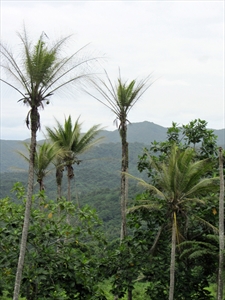- Narrow distribution. Southwest Pacific. On coconut, sago palm, Pandanus and some wild palms. Outbreaks occur, when it is an important pest.
- Adults strip leaflets, leaving the midrib. Occasionally, defoliation occurs over several hundred hectares. Mature palms >25 m most affected.
- Eggs in the crown, fall into the leaf base, leaf litter or weeds. Nymphs climb to the crown. Only males fly.
- Natural enemies: chickens and myna birds take nymphs on the ground. There are parasitoid wasps that have been bred for biocontrol purposes.
- Cultural control: sticky bands around trunks (e.g., 'Tanglefoot'); control weeds to expose eggs to sun; intercrop with cocoa – nymphs climb the cocoa and starve; note, lighting fires to smoke the insects no longer acceptable as fires damages the palms.
- Chemical control: none recommended.








